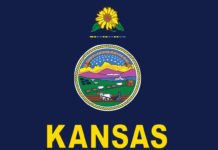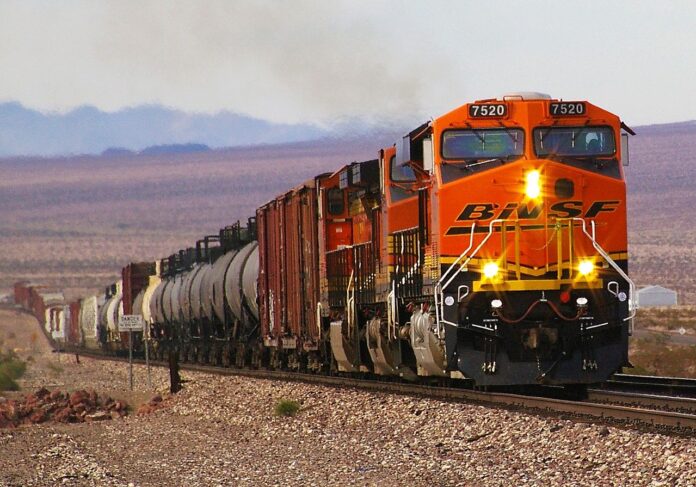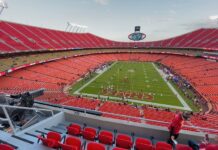The Kansas Senate stood up to the powerful railroad industry Tuesday, passing a bill that would force railroads to run shorter trains in an effort to enhance rail safety.
The chamber voted 27-13 to set aside objections from BNSF Railway to pass a bill from operating any train that exceeds 8,500 feet in length.
The bill also requires rolling stock stored on sidings to be at least 250 feet from a railroad crossing if the crossing doesn’t have electronic warning signals.
Penalties for violations of either rule range from $500 to $100,000.
The bill would sunset on July 1, 2027. It now goes to the House.
While far from a done deal, passage of the bill in the Senate was seen as a breakthrough moment against the railroad lobby.
“It’s been a tradition ever since the middle 1800s. When they started, by design it was ‘Don’t regulate us,'” Republican state Sen. Carolyn McGinn said of the railroads.
McGinn, who chairs the local government committee, has been trying to address the issue because of the danger and convenience problems that she said long trains pose for small rural communities.
The shift in the mood against the railroads, she said, has come as the public has become more inconvenienced by trains extending more than a mile in length.
“We’re one of many states that are passing these now because (the public) is frustrated and because the federal government won’t take charge and do anything,” she said.
“We are the ones that hear from our constituents about having their community cut in half, late to appointments, can’t get to the hospital,” she said.
“It’s been an inconvenience.”‘
BNSF Railway opposed the bill. The railroad said it doesn’t believe the state has the legal authority to regulate railroads. The company did not return emails seeking comment on the bill on Monday and Tuesday.
The company told lawmakers that running smaller trains would interrupt interstate freight traffic, cause shipping delays and increase costs for consumers because trains will have to stop to be broken down before they enter Kansas.
Ty Dragoo, the Kansas state legislative director for transportation workers, said passage of the bill in the Senate was significant.
“It is a David vs. Goliath story,” Dragoo said of the unions taking on the railroads.
“We’re outfunded 50 to 1 – if that’s even accurate,” he said. “We’ve been really a one-person show up here when it comes to interests.”
Senate Majority Leader Larry Alley said he understood the inconvenience posed by long trains, but passed on voting on the bill.
“It seems to be that long trains are blocking our railways, are blocking intersections and it causes concerns for our constituents,” Alley said.
“It’s unclear whether or not these long trains cause these derailments. We don’t know what caused each and every derailment,” he said.
“What we do know is our economy does run on a rail,” he said. “We also know that our suppliers bring their products in and out and to market through the rail.”
Alley suggested that an interim committee be formed to study the issue further.
The bill emerged weeks after a Norfolk Southern train carrying toxic chemicals derailed in East Palestine, Ohio, which started a fire and raised concerns about the effect on the health and environment for residents.
Train derailments were up about 6.3% nationally last year from 2021, although they were down about 13% since 2019, according to Federal Railroad Administration data.
Overall, train accidents and incidents increased 4.5% in 2022 from a year earlier, according to FRA data. They were down about 17% since 2019.
However, the state has been grappling with rail safety in other ways beyond the train length, which has been growing.
Three years ago, a court for the first time in 100 years ruled that Kansas law couldn’t be used to limit how long trains can block railroad crossings.
The Kansas Court of Appeals ruled that the state could not regulate how long a train could block a railroad crossing because it’s preempted by federal law.
The appeals court found that the 1923 law, which barred trains from blocking intersections for more than 10 minutes without leaving a 30-foot opening, was superseded by the Interstate Commerce Commission Termination Act.
The federal law created the Surface Transportation Board, which has the exclusive authority to regulate the railroads.
The three-judge panel ruled that because the law is aimed at the railroads and has an effect on operations, it infringes upon the jurisdiction of the Surface Transportation Board.
The decision cited the authority of the Surface Transportation Board as the sole entity to regulate railroad activities in the United States.
Late last year, the state of Ohio asked the U.S. Supreme Court to decide whether states can limit the amount of time trains are allowed to block railroad crossings.
Former Attorney General Derek Schmidt joined a friend-of-the-court brief along with other states supporting Ohio’s appeal of a lower-court ruling that struck down the Ohio law limiting how long a train could block a railroad crossing.
Also, Democratic Gov. Laura Kelly tried to impose a rule that she believed would enhance rail safety in Kansas.
She proposed requiring railroads operating in Kansas to have at least two crew members in the cab of the lead locomotive.
However, Schmidt blocked approval of the rule in September 2020.
The attorney general said the rule was not approved because it was preempted by federal law and the state did not have the statutory authority to impose the regulation.
The attorney general relied partly on a 2018 state appeals court ruling that said the state could not regulate how long a train can block a railroad crossing.
Train length has been an issue in Kansas because of how it affects small communities.
Two years ago, the Newton city manager told a Senate committee about how blocked crossings were contributing to increased response times for emergency responders.
“The increased number and growing length of the trains remains an ongoing concern for our community and many others in the region,” Kelly McElroy said.
A U.S. Government Accountability Office report from 2019 found that freight trains have been getting longer, nearly three miles in some instances.
The report said that increasing train length has raised concerns that trains may block traffic more often at railroad crossings, slow down emergency responders and foster dangerous pedestrian behavior.
Using data provided by two Class I railroads, the GAO found that average train length has increased by about 25% since 2008, with average lengths of 1.2 and 1.4 miles in 2017.
Officials from all seven Class I railroads told the GAO said they were operating longer than average trains on specific routes, although some said those trains are a small percentage of the trains they operate.
Officials told the GAO that they ran longer trains to achieve increased efficiencies and economic benefits.
The audit criticized the the Federal Railroad Administration for not assessing whether
longer freight trains affect communities by blocking more crossings.
“FRA faces a challenging task in assessing the safety impacts of longer trains and has taken some important steps to collect needed information,” the audit said
“However, without documented strategies for how it plans to communicate the results of its research, FRA may lose an opportunity to effectively work with internal and external stakeholders — such as railroads, railroad workers, and local communities — to address any risks of operating longer trains,” the audit said.
Train safety has been getting more attention nationally this year, especially following the Ohio derailment last month.
At least 15 states have introduced rail-safety bills this year addressing issues such as onboard crew sizes, train length and the use of trackside safety detectors.
Most of the legislation was introduced before the Norfolk Southern derailment but has gained momentum in the following weeks.
At least three states – Iowa, Arizona and Washington – are considering bills this year that would limit train length.
Washington wants to go 7,500 feet compared to all other states such as Kansas that want to limit the length to 8,500 feet, or about 1.6 miles.
Adam Weiskittel, associate general counsel for BNSF Railway, recently told the Senate Transportation Committee that railroads are regulated by the Surface Transportation Board and the Federal Railroad Administration.
“State law dictating to railroads the length and operation of trains and how they may or may not use their property to store their equipment are efforts by the state to regulate in areas that Congress has reserved for the STB and the FRA and thus would be unenforceable,” he said.
Republican state Sen. Tim Shallenburger, a member of the Senate Transportation Committee, asked Weiskittel directly if the bill was legal.
“You’re saying none of this bill is legal?” Shallenburger asked the BNSF executive.
In response, Weiskittel said the railroad believed the bill would “clearly” be preempted by federal law.
















